 Mysteries
Mysteries  Mysteries
Mysteries  History
History 10 Surprising Stories About the Texas Rangers
 Humans
Humans 10 Philosophers Who Were Driven Mad by Their Own Theories
 Miscellaneous
Miscellaneous 10 Video-Game-Worthy Weapons and Armors from History
 Weird Stuff
Weird Stuff 10 Psychics Who Accurately Predicted Wartime Events
 The Arts
The Arts 10 Pieces of Art Inspired by a Broken Heart
 Health
Health 10 Science Fiction-Sounding New Medical Treatments
 History
History 10 Surprising Facts About the Father of Submarine Warfare
 Space
Space Ten Astonishing New Insights into Alien Worlds
 Weird Stuff
Weird Stuff 10 Bizarre Summer Solstice Rituals Still Practiced Today
 Mysteries
Mysteries Top 10 Haunting Facts About the Ghost Ship MV Alta
 History
History 10 Surprising Stories About the Texas Rangers
 Humans
Humans 10 Philosophers Who Were Driven Mad by Their Own Theories
Who's Behind Listverse?

Jamie Frater
Head Editor
Jamie founded Listverse due to an insatiable desire to share fascinating, obscure, and bizarre facts. He has been a guest speaker on numerous national radio and television stations and is a five time published author.
More About Us Miscellaneous
Miscellaneous 10 Video-Game-Worthy Weapons and Armors from History
 Weird Stuff
Weird Stuff 10 Psychics Who Accurately Predicted Wartime Events
 The Arts
The Arts 10 Pieces of Art Inspired by a Broken Heart
 Health
Health 10 Science Fiction-Sounding New Medical Treatments
 History
History 10 Surprising Facts About the Father of Submarine Warfare
 Space
Space Ten Astonishing New Insights into Alien Worlds
 Weird Stuff
Weird Stuff 10 Bizarre Summer Solstice Rituals Still Practiced Today
10 Ridiculously Specific Predictions That Came True
Common sense tells us that it’s not really possible to predict the future in any way, shape or form. Even the most off-handed, silly predictions will be correct from time to time; this is what we like to call the “Accidental Prophet Effect”, which is closely related to the “Even a Broken Clock Is Right Twice a Day Theorem”. Of course, some actually claim to be able to foresee future events, but these people almost invariably turn out to be full of crap.
Note that we said “almost”. Because there do exist instances of absurdly accurate prognostication that can’t be explained by APE (in case you didn’t notice that acronym), and that make Nostradamus look like the hack that he was.

Predicted: Modern displays and movie streaming in 1987
In 1987, beloved movie critic Roger Ebert gave an interview for Omni magazine in which he was asked a pretty simple question: how did he think the competition between movies and television would shape up in the future? His answer probably sounded like that of a chin-scratching intellectual then; it sounds like the words of a damn prophet today:
“We will have high-definition, wide-screen television sets and a push-button dialing system to order the movie you want at the time you want it. You’ll not go to a video store but instead order a movie on demand and then pay for it. Videocassette tapes as we know them now will be obsolete both for showing prerecorded movies and for recording movies. People will record films on 8mm and will play them back using laser-disk/CD technology . . . With this revolution in delivery and distribution, anyone, in any size town or hamlet, will see the movies he or she wants to see.”
Now, “push-button dialing” is a phrase that seems rather of its day, but consider the rest. “On Demand” cable barely existed; cable TV in general was in its infancy. The technology that would enable video streaming wasn’t just in its infancy, it was embryonic. Laser Discs and CDs existed, but a hybrid of the two—DVDs—wouldn’t for about a decade, and did anyone even know what “high-definition” or “wide-screen” meant back then? This was a time when the black bars at the top and bottom of the screen in widescreen home video releases were often thought by consumers to be a defect. We would love to hear Ebert’s answer to the same question today.

Predicted: 100% of 2013 Golden Globe winners accurately
Policymic is a political news and culture website/forum that launched in 2011. In January 2013, their culture editor Elena Sheppard was assigned to live blog the Golden Globe Awards, and pulled off a feat of prognostication that nobody on record ever has before.
Of course, part of the assignment was speculating on which films and TV shows would take home which prizes—and as with the Oscars and Emmys, there are always odd choices among the no-brainer wins. One would probably have better odds of getting struck by lightning on the red carpet than predicting every last win with one hundred percent accuracy—yet that’s exactly what Elena did.
That’s a perfect 25 for 25, and even allowing for the fact that Elena knows a lot about movies and TV, well . . . so do a lot of people. Professional people who are paid to make these kind of predictions, yet somehow fail to do so with complete accuracy year after year. We have a few questions to ask Elena in advance of our trip to Las Vegas.
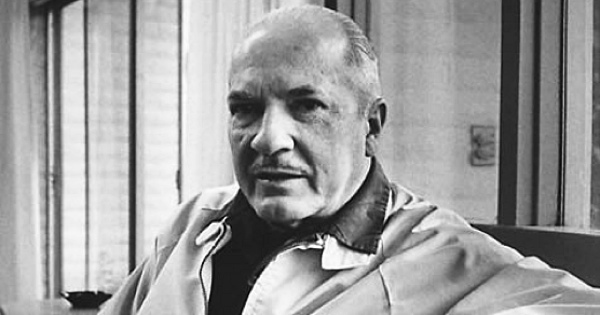
Predicted: The Cold War. Also, waterbeds.
Heinlein will not be the only science fiction author on this list; authors in that genre are of course known for looking into the future and extrapolating what it might hold. Heinlein certainly had his share of speculations about the future which turned out to be pretty accurate—but a couple of them were mind-bogglingly specific.
In his short story “Solution Unsatisfactory”, Heinlein depicted a United States that develops a nuclear weapon before the rest of the world, becoming the only superpower and spurring a race among the other nations of the world to develop the bomb. This is, of course, a perfect description of the nuclear arms race and the Cold War, which kicked off after the US deployed nuclear weapons against Japan in 1945. “Solution”, however, was written in 1940—before the United States had even joined World War II, and when the feasibility of nuclear weapons was still largely speculation.
Almost stranger than this is Heinlein’s near-invention of the waterbed. His 1961 novel Stranger In a Strange Land contained a detailed description of such a bed—so detailed that the eventual inventor of the waterbed had trouble getting it patented. The patent wasn’t issued until 1971, and Heinlein claimed to have had the idea as far back as the 1930s.
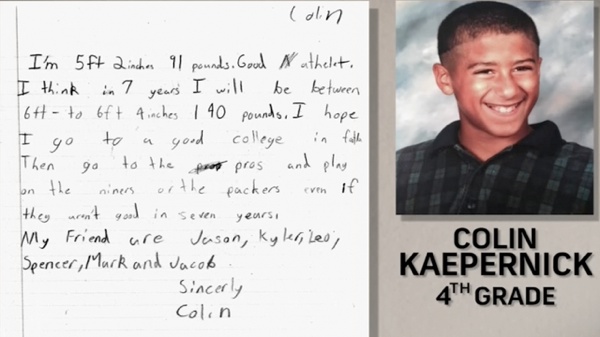
Predicted: Team he would play pro football for as a nine-year-old.
Colin Kaepernick was drafted by the San Francisco 49ers in 2011, and spent his entire rookie season on the bench behind Alex Smith, who was having a breakout year; the Niners would eventually lose the NFC Championship to the eventual Super Bowl champion New York Giants. Kaepernick threw for 257 yards, no touchdowns and five interceptions in relief of Smith that year; there’s no way he could have predicted he’d be the Niners’ starter the following season, and he didn’t. He predicted it when he was a grade schooler.
Nine-year-old Colin, describing himself as a “good athelet” stated in the school assignment seen above his intention to play for the 49ers, or possibly the Packers, “even if they aren’t good in seven years”. Okay, so his spelling and math might have been a little questionable, but his predictive powers were mighty impressive—even if he got one aspect slightly off; the cannon-armed quarterback’s breakout game in 2012 was a 45-31 destruction of the Green Bay Packers.
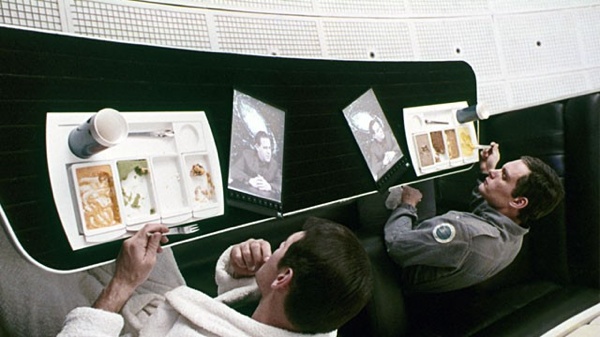
Predicted: The iPad and online newspapers in 1968.
Famed science fiction author Arthur C. Clarke employed an unprecedented collaborative process with Stanley Kubrick to complete the film and novel versions of 2001: A Space Odyssey. Author and director frequently compared notes; the novel and screenplay were written simultaneously, with Kubrick contributing heavily to Clarke’s work and vice-versa. One bizarrely accurate prediction makes a prominent appearance in both: in the film 2001, two astronauts can be seen reading a newspaper on something that looks suspiciously like an iPad.
As odd as that is, the description—and name—of the device given in Clarke’s novel is even more startling:
“When he had tired of official reports, memoranda and minutes, he would plug his . . . Newspad into the ship’s information circuit and scan the latest reports from Earth. One by one, he would conjure up the world’s major electronic papers . . . Each had its own two-digit reference. When he punched that, a postage-sized rectangle would expand till it neatly filled the screen and he could read it with comfort. When he finished he could flash back to the complete page and select a new subject for detailed examination . . . one could spend an entire lifetime doing nothing but absorbing the ever-changing flow of information from the news satellites.”
This description, and the depiction in Kubrick’s film, were so dead-on that Samsung used them in defense of its Galaxy tablet when Apple sued for patent infringement—litigation that is still pending in US courts.
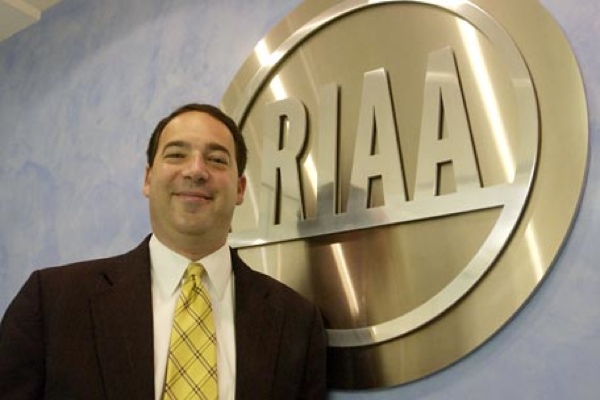
Predicted: The RIAA shaking down radio stations in 2002.
The satirical newspaper The Onion is a fantastic source of hilarity of both the intentional and non-intentional varieties. Not only is the publication reliably funny on purpose, but there have been numerous recent instances of non-US news organizations—ones that are presumably mystified by Western satire—picking up Onion stories and reporting on them as if they were fact. Unfortunately, it can be a lot less funny when an Onion piece actually DOES come true.
In 2002, the RIAA was fresh from its successful battle with Napster, and the debate over online piracy was beginning in earnest; lawsuits against individuals for file sharing were ramping up, and the Onion published a timely piece entitled, “RIAA Sues Radio Stations For Giving Away Free Music”. The premise is, of course, ridiculous—at least it was, until 2008.
At around the same time the RIAA announced it was ceasing action against individuals (if only because they were proving unprofitable), they began to make noise about radio broadcasting being:
” . . . a form of piracy, if you will, but not in the classic sense as we think of it,” said Martin Machowsky, a musicFirst spokesman. ” . . . their argument (is) that they provide promotional value. We think that’s a red herring. Nobody listens to the radio for the commercials.”
We don’t think that was actually the argument. We think the argument was that without radio exposure, the music industry as we know it wouldn’t exist. So far the RIAA has been unsuccessful in most of their wildly varied attempts at extortion, but not for lack of trying.
Predicted: Touchscreen devices and Siri in 1987.
In 1987 (a great year for future-predicting, if you ask Roger Ebert), Apple made a promotional video entitled “Knowledge Navigator”, which looked into the future at some of the tech innovations that might be part of our lives in oh, say, 25 years or so. As you may be able to predict (sorry), the accuracy gets more and more unsettling throughout.
The video depicts a professor preparing for that afternoon’s lecture. His work is being done on a proto-iPad , a flat tablet PC (with an old-style Mac OS) with a touchscreen, and that’s the least weird aspect if this video.
Most of his interaction is done through the titular “Knowledge Navigator”, which is a voice-controlled assistant the likes of which you may associate with certain Apple products. During his work, the professor takes a video call from a colleague right in a separate window on his device, which of course is Skype in a nutshell.
Weirdest of all, at one point the professor calls up a five-year old article that is stated to be from 2006. A calendar is shown with September being the current date; this means that the video must take place sometime in late 2011, right about the time the iPhone 4S launched—and Apple’s voice-controlled assistant Siri debuted. If only she had a cool Steve Nye-looking avatar, like in the video.
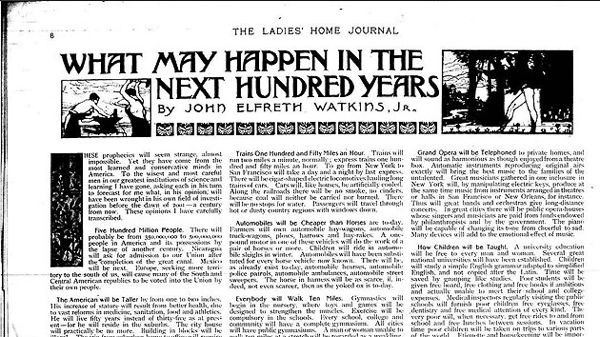
Predicted: Television and mobile phones in 1900.
Mr. Watkins was a civil engineer, a railroad man who became a curator at the Smithsonian Institute after suffering a disabling accident. In 1900, he contributed an article to Ladies’ Home Journal titled “What May Happen in the Next Hundred Years”. Within this article, Mr. Watkins made lots of predictions, large and small, for the next century; some of these proved, despite their counter-intuitiveness, to be amazingly accurate. Among the more astonishing predictions—and keep in mind this was over a hundred years ago:
“Man will see around the world. Persons and things of all kinds will be brought within focus of cameras connected electrically with screens at opposite ends of circuits, thousands of miles at a span.” —could apply to satellite television, the Internet, or both.
“There will probably be from 350,000,000 to 500,000,000 people in America.” —most were guessing much higher at the time, as the American population was exploding.
“Ready-cooked meals will be bought from establishment similar to our bakeries of today.” —Freeze-dried and packaged foods, not to mention electric refrigerators, were still far on the horizon.
“Photographs will be telegraphed from any distance. If there be a battle in China a hundred years hence, snapshots of its most striking events will be published in the newspapers an hour later . . . . photographs will reproduce all of nature’s colors.” —digital photography and picture sharing. And perhaps most impressive of all:
“Wireless telephone and telegraph circuits will span the world. A husband in the middle of the Atlantic will be able to converse with his wife sitting in her boudoir in Chicago. We will be able to telephone to China quite as readily as we now talk from New York to Brooklyn.” —nobody on the planet not named Tesla was thinking along these lines, except apparently Mr. Watkins.
Unfortunately, Watkins died before seeing a single one of his predictions come to fruition, in 1903.
Predicted: Online shopping and email in 1967.
Philco was an early pioneer in electronics, beginning in 1892 as a maker of carbon arc lamps, and eventually becoming the most popular early manufacturer of radios. The company was bought by the Ford Motor Company in 1961, and in recognition of their 75th anniversary, they produced a short film speculating on life in the far, far future. Its title: “Year 1999 A.D.”
While the aesthetic of the film is very much of its time, and many of the fine details are rooted firmly in the ’60s, the list of everyday technologies predicted in this brief two-minute clip are astounding.
Here we have 1960s conceptions of online shopping and bill paying, electronic funds transfers, compact home laser printers, and even “instant written communication between individuals anywhere in the world”—a perfect definition of email, long before the Internet was a twinkle in anyone’s eye. When this video started making the online rounds in the mid ’00s, it was scarily accurate enough to be thought a hoax, until confirmed by Snopes. Not QUITE accurate enough to disregard ’60s gender stereotypes, but we digress.

Predicted: Practically all modern technological developments.
Raymond Kurzweil’s life and career are far too interesting to do complete justice to here. His inventions are numerous—text reading software, speech-recognition devices—and five of his novels have been bestsellers. He is the current Director of Engineering at Google, and as a “futurist”, he’s made dozens of predictions over the several decades—with an absolutely unbelievable rate of accuracy. Not only do Kurzweil’s predictions almost always come true, he usually can accurately predict WHEN they will come true.
Among the many, many examples: in his novel The Age Of Intelligent Machines, Kurzweil predicted the fall of the Soviet Union by 1991; a computer beating the best human players at chess by 2000; and wireless Internet becoming practical for mainstream use in the early 21st century. In The Age Of Spiritual Machines (1999), he predicted E-books, face recognition software, and nanotechnology, and these are just a handful of examples.
Kurzweil stated that by 2009, 89 out of 108 predictions he had made were entirely correct. Of the rest, 13 were “essentially correct”—likely to come true within a few years. A re-evaluation in 2012 determined that Kurzweil’s prognostications are correct a ridiculous 86 percent of the time-and the good news is, this is a man who has predicted that it won’t be too long before we humans conquer death altogether.
Floorwalker’s blog and Twitter were probably predicted by someone long ago, but they’re still pretty cool.








